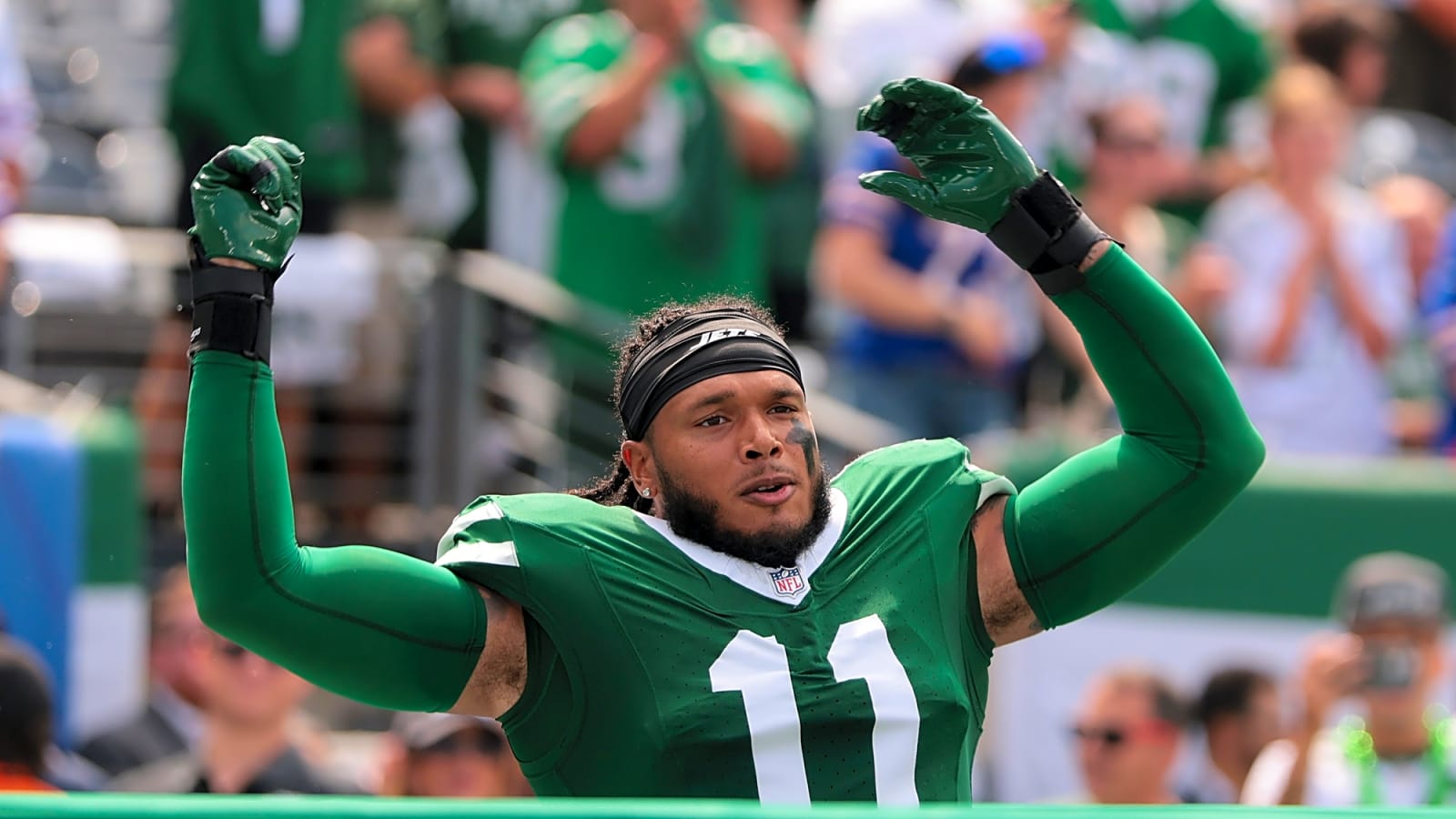
Through five weeks, the New York Jets’ defense was nothing short of a punchline. You know things are bad when one of your best defenders admits he plays on the worst unit in football.
“When you’re probably the worst defense in the league, no matter where you’re at, you got to fix things if you want to win football games and go in the right direction,” said Quinnen Williams after the defense’s fifth straight game recording no takeaways. New York’s defense was also responsible for allowing 30 points per game over that span.
In their Week 6 trip to London, the Jets’ defense showed its first signs of life—and it went much further than merely surpassing league-worst standards. New York put a stranglehold on Bo Nix and the Denver Broncos, limiting Sean Payton’s offense to 13 points, 246 yards, and 12 first downs.
WATCH: Joe Blewett's Jets-Broncos Film Review (Defensive Standouts, Fields' Sacks, and More)It was a shutdown effort that nearly willed the Jets to victory despite the offense’s historically inept performance. In fact, it’s one of the franchise’s most impressive defensive performances in recent memory. The Jets’ total of 12 first downs allowed ranks as their third-fewest in a game away from MetLife Stadium over the past decade.
The overnight shift from joke to juggernaut didn’t happen out of nowhere. New York was buoyed by multiple changes to the starting lineup.
Jets’ positive changes to defensive lineup
The Jets made two critical changes to a secondary that bled wide-open receptions over the first five weeks. Both changes made the defense younger and more fundamentally sound.
Starting safety Tony Adams was benched in favor of fourth-round rookie Malachi Moore. It was an overdue change after Adams struggled mightily through five weeks.
The switch paid dividends. Moore had a quiet game, which is typically positive for an every-down starting safety. The rookie didn’t do anything noteworthy, but he was never targeted in coverage and did not miss any tackles. New York will gladly sign up for that after Adams yielded 85 yards in coverage and missed four tackles across his four starts.
The Jets also debuted Jarvis Brownlee as their new starting slot corner in place of the injured Michael Carter II. Brownlee’s tenacity and gap-disciplined tackling approach were much-needed for a back-seven that was struggling with missed tackles.
The biggest boost of all, though, was the return of edge rusher Jermaine Johnson.
Johnson’s presence was the top reason for New York’s defensive turnaround, and it can change everything for the Jets moving forward.
Can Jermaine Johnson save the Jets’ defense?
After missing the previous three games with an ankle injury, Johnson immediately displayed his value to the Jets’ defense. He finished the game in Denver with five tackles, one sack, and three pressures while providing excellent edge-setting against the run.
Johnson began the 2025 season red-hot, showing no ill effects from the Achilles tear that ended his 2024 campaign in Week 2. He was flying around the field making plays against both the pass and the run, already racking up six pressures and six tackles through 1.5 games.
Most notably, the Jets did not employ any sort of ramp-up period, instead opting to immediately give Johnson the largest role of his career. He played a career-high 89% of the defensive snaps in Week 1 and was well on his way to that mark in Week 2 until he suffered an injury two minutes before halftime.
Upon his return in Week 6, the Jets limited Johnson’s workload compared to the start of the season, but they still played him on 63% of the defensive snaps, leading New York’s edge rushers. With the Jets’ edge unit becoming a colossal weakness during Johnson’s absence, the desperate Jets did not hesitate to thrust him back into a featured role.
This defense needs him, and it shows in the numbers.
In both phases, the Jets are a completely different defense with Johnson on the field. His presence alone is the difference between New York looking pillow-soft and respectable.
With Johnson off the field this season, the Jets have allowed 4.4 yards per designed rush attempt. This would rank 26th in the NFL. With Johnson on the field, they are allowing only 2.8 yards per designed rush attempt, which would lead the NFL.
Yards allowed per designed rush attempt:
- Jets with Johnson (2.8)
- 1. Seattle (3.0)
- 2. Cleveland (3.0)
- 3. Tampa Bay (3.1)
- 4. New England (3.2)
- 5. New Orleans (3.3)
- …
- 25. Baltimore (4.3)
- Jets without Johnson (4.4)
- 26. Tennessee (4.4)
- 27. Cincinnati (4.4)
- 28. LA Chargers (4.5)
While Johnson’s impact is not as massive in the passing game, it’s still palpable.
With Johnson on the sidelines, the Jets have recorded eight quarterback hits on 137 passing plays, a 5.8% rate. This would rank last in the NFL. With Johnson on the field, they have nine quarterback hits on 73 passing plays, a 12.3% rate. It would still rank only 27th in the league, but it’s more than double their pitiful rate without him.
Percentage of passing plays recording a QB hit (sack or knockdown):
- 25. Jacksonville (12.6%)
- 26. Las Vegas (12.4%)
- 27. Miami (12.3%)
- Jets with Johnson (12.3%)
- 28. Baltimore (11.9%)
- 29. Cincinnati (10.9%)
- 30. NY Jets (8.9%)
- 31. San Francisco (6.7%)
- 32. Carolina (6.4%)
- Jets without Johnson (5.8%)
These numbers provide hope for the Jets’ defense moving forward. As long as Johnson is healthy, the unit has a much higher ceiling than it did while he was absent.
This is especially true in the run game. Johnson’s presence is enough to make the Jets perform at the caliber of the league’s top run defense. Take him out, and teams run all over them.
While Johnson cannot single-handedly save the Jets in the passing game, he makes enough of an impact to lift New York’s pass rush from CFL caliber to at least good enough to pass for an NFL team.
Johnson’s presence is critical for a Jets defense with poor depth along the defensive line. When everyone is healthy, the Jets have excellent talent at the top; a lineup of Johnson, Quinnen Williams, Harrison Phillips, and Will McDonald can go toe-to-toe with almost any other starting four in the NFL.
But when the next man up after Johnson is the likes of Micheal Clemons or Braiden McGregor, it’s no surprise that the team sees such a massive dip in performance when Johnson is sidelined. That’s why Johnson’s on-off numbers are so stark; the players replacing him are liabilities.
Still, the poor depth should not diminish Johnson’s role in his on-off numbers. Part of the reason his presence has such a big impact is that he excels at doing the little things to set up his teammates for success.
On this Quinnen Williams sack in Week 1, it’s Johnson’s pressure off the edge that forces Aaron Rodgers to step up into the sack.
On this end-around toss, Johnson diagnoses the play and gets downhill, forcing the runner to retreat vertically and string out the play. While Johnson does not make the stop, he buys time for Jamien Sherwood to rally and stuff it for a minimal gain.
It’s a massive difference-maker compared to what Clemons, McGregor, or Tyler Baron would do in the same spot.
Johnson doesn’t solve everything, but he raises expectations for the coaching staff
Moving forward, it will be interesting to see if Steve Wilks can use Johnson’s presence to begin saving face after a much-maligned start to his New York tenure.
Wilks has drawn plenty of justified criticism for the unit’s performance this season. However, it’s fair to say that the talent downgrade without Johnson was a difficult obstacle for any coach to overcome. It doesn’t excuse being quite as bad as the Jets were through Week 5, but it is worth noting.
Now that Johnson is back, it seems fair to say that New York’s defense has more than enough talent to be a respectable group at the very least. As long as Johnson is on the field, the Jets have few excuses for being anywhere close to the league’s worst defense (with their current health across the depth chart).
Despite the breakout game against Denver, the Jets still rank as one of the league’s worst defenses this season. They are 25th in defensive DVOA and 28th in garbage time-adjusted EPA per play. Last week was a big step forward, but the Jets must stack performances like that to save Wilks’ job.
While Johnson will be a critical boost, it’s much too early to claim that everything will be sunshine and rainbows now that he’s healthy. The Jets’ defense struggled with Johnson on the field from Weeks 1-2. They allowed 54 points in six quarters before his ankle injury.
Even if you add the Denver game, that’s 67 points allowed in 10 quarters with a healthy Johnson, which equates to 26.8 points per game. That’s just not good enough.
Johnson’s return will not single-handedly save the Jets’ defense. However, he undeniably raises the unit’s ceiling, which only brightens the limelight on Wilks and head coach Aaron Glenn. If they cannot get the Jets’ defense to meet expectations with a healthy Johnson, New York might be looking for a new defensive coordinator (and perhaps head coach) in the offseason.
More must-reads:
- Aaron Rodgers sends message to Steelers after disappointing loss to Bengals
- Rams give disappointing injury update on Puka Nacua ahead of London game
- The 'NFL 100-touchdown club' quiz
Breaking News
Trending News
Customize Your Newsletter
 +
+
Get the latest news and rumors, customized to your favorite sports and teams. Emailed daily. Always free!








